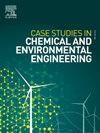电石渣废弃物二氧化碳固存潜力的建模与优化
Q1 Environmental Science
Case Studies in Chemical and Environmental Engineering
Pub Date : 2025-06-12
DOI:10.1016/j.cscee.2025.101250
引用次数: 0
摘要
工业废物的矿物碳化作为一种很有前途的减少二氧化碳排放的方法受到了广泛的关注。研究了电石渣在实际条件下的湿相MC捕集和封存CO2。采用响应面法和中心复合设计对电石渣渣湿相MC进行了优化建模。分析了温度、压力、相对湿度、液固比(L/S)和CO2加载率等5个操作参数对CO2捕集能力和反应动力学的单独和交互影响。此外,开发了二次模型来预测二氧化碳捕获能力和50%碳化转化所需的时间(time50)。结果表明,对CO2捕集能力影响最大的因子是压力,其次是L/S比。而time50主要受CO2加载速率和压力的影响。CO2捕集能力和时间50的二次模型R2值分别为0.9863和0.9986。此外,两种反应的模型预测结果与实验结果非常接近。优化后的条件下,在65°C、10 bar压力、0.2 L/S比和75%相对湿度条件下,121分钟的CO2捕集量最大为11.9 mol kg−1,其中50%的转化率在前52分钟发生。综上所述,电石渣湿相MC是解决工业废物利用和减少二氧化碳排放的一种很有前途的方法。在各种实验条件下获得的高CO2捕集能力表明电石渣是大规模CO2捕集应用的可行候选者。此外,技术经济分析和可扩展性评估对于促进这种方法的工业相关性至关重要。本文章由计算机程序翻译,如有差异,请以英文原文为准。
Modelling and optimization of carbon dioxide sequestration potential of carbide slag waste
Mineral carbonation (MC) of industrial wastes has gained significant attention as a promising approach for reducing carbon dioxide (CO2) emissions. This study investigates the wet-phase MC of carbide slag waste at realistic conditions for CO2 capture and storage. Response Surface Methodology with a central-composite design was employed for optimization and modeling for wet-phase MC of carbide slag waste. Five operational parameters namely temperature, pressure, relative humidity, liquid-to-solid (L/S) ratio, and CO2 loading rate were analyzed for their individual and interactive effects on CO2 capture capacity and the reaction kinetics. Further, quadratic models were developed to predict CO2 capture capacity and time required for 50 % carbonation conversion (time50). The results revealed that the most influential factor was pressure followed by the L/S ratio for CO2 capture capacity. While time50 was majorly influenced by the CO2 loading rate and pressure. The quadratic models for CO2 capture capacity and time50 have an R2 value of 0.9863 and 0.9986, respectively. Moreover, the results predicted from the models for both responses were closely aligned with the experimental results. The optimized conditions yielded a maximum CO2 capture capacity of 11.9 mol kg−1 at 10 bar pressure, 65 °C, in the presence of 0.2 L/S ratio and 75 % relative humidity in 121 minutes, where 50 % conversion occurs in the first 52 minutes. In conclusion, wet-phase MC of carbide slag represents a promising approach to address both industrial waste utilization and CO2 reduction. The high CO2 capture capacity achieved under various experimental conditions demonstrates carbide slag as a viable candidate for large-scale CO2 capture applications. Furthermore, techno-economic analysis and scalability assessments will be crucial in advancing this approach to industrial relevance.
求助全文
通过发布文献求助,成功后即可免费获取论文全文。
去求助
来源期刊

Case Studies in Chemical and Environmental Engineering
Engineering-Engineering (miscellaneous)
CiteScore
9.20
自引率
0.00%
发文量
103
审稿时长
40 days
 求助内容:
求助内容: 应助结果提醒方式:
应助结果提醒方式:


